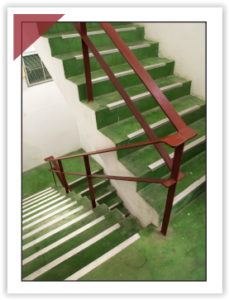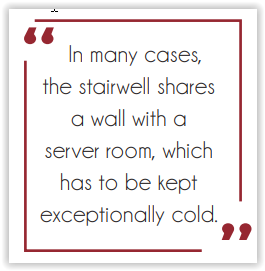Stairway to Nowhere
WHEN THERMAL BRIDGING GUIDES MOLD INTO YOUR BUILDING
 Over the last 10 years, whenever I get a call in late August or early September, I can guess what the problem is before I even answer the phone. The ends of my summers are almost always spent in hot, humid stairwells, looking at mold.
Over the last 10 years, whenever I get a call in late August or early September, I can guess what the problem is before I even answer the phone. The ends of my summers are almost always spent in hot, humid stairwells, looking at mold.
By now, when someone calls me about mold in the stairwell, I have a pretty good idea what the cause is. When I arrive at the building, I find myself walking up a stairwell that’s 80–85 degrees, with 75% humidity, until I reach a wall covered in mold. It’s never the whole stairwell, mind you. The mold is only on a single wall. Sometimes, when I climb another five or six flights of stairs, mold will appear on that same wall. Inevitably, there will be more mold on that wall when I climb another five flights.
Tenants or property managers see mold on the wall and instantly think it’s water damage, but when mold appears in a stairwell like this, the key to the problem is what’s on the other side of the wall. In many cases, the stairwell shares a wall with a server room, which has to be kept exceptionally cold. The insulation inside the wall between the stairwell and the server room isn’t enough to prevent the transfer of thermal energy — a phenomenon called thermal bridging.
Thermal bridging occurs when heat is able to flow through an object that’s more conductive than the rest of the material round  it. In the case of a moldy stairwell, the cold temperature is able to move through the wall-board studs of the server room into the wall-board studs of the stairwell. The stairwell with its high heat and humidity creates the perfect environment for the surface of the wall board to reach dew point, which is when condensation occurs. That condensation supports the growth of
it. In the case of a moldy stairwell, the cold temperature is able to move through the wall-board studs of the server room into the wall-board studs of the stairwell. The stairwell with its high heat and humidity creates the perfect environment for the surface of the wall board to reach dew point, which is when condensation occurs. That condensation supports the growth of
mold. Since the server room is kept so cold and the stairwell is so hot and humid, standard insulation is insufficient to prevent thermal bridging.
A building I examined recently was suffering from mold in the stairwell. Their plan was to cut out the Sheetrock and replace it, but that wasn’t going to fix the problem. Mold would still grow because the server room would still be cold, the stairwell would still be hot and humid, and thermal bridging would still occur. My solution was for them to clean the wall, treat it with biocide to make sure the mold was gone, repaint the wall, and put insulation board up in the server room on the wall it shared with the stairwell. They didn’t have to tear up the wall and the added insulation would keep the wall from getting too cold.
When it comes to mold, the best way to deal with it is to prevent its growth in the first place. There are two ways to prevent thermal bridging from happening in your building stairwell. First, you could air condition the stairwell so it’s the same temperature as the rest of the building. However, since this is often unreasonable and expensive, I recommend the second option: Improve the insulation in the server room.

